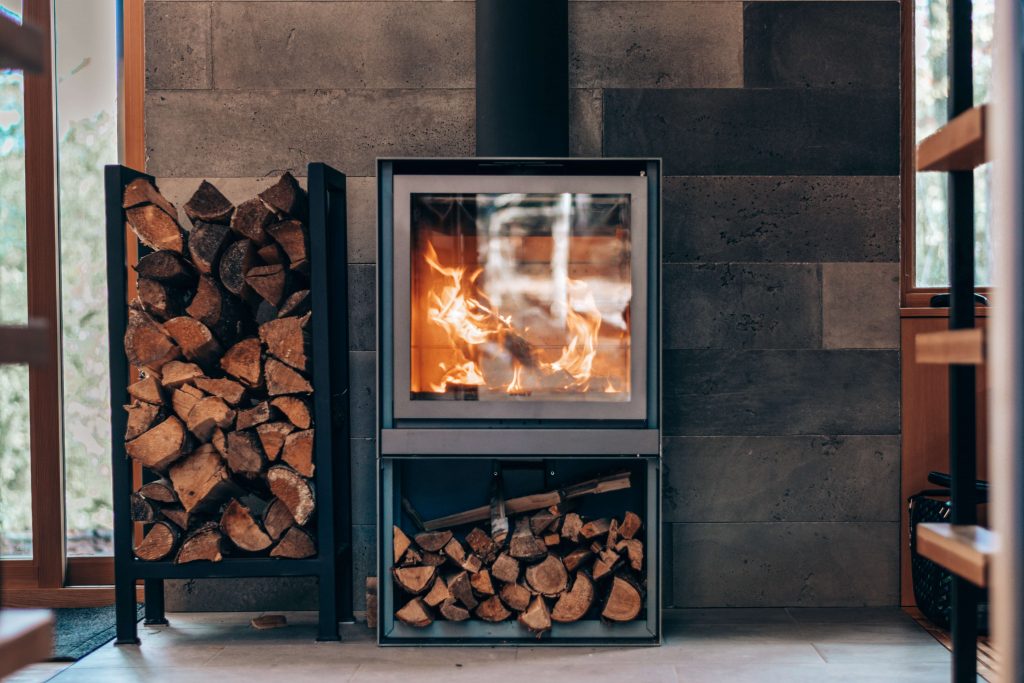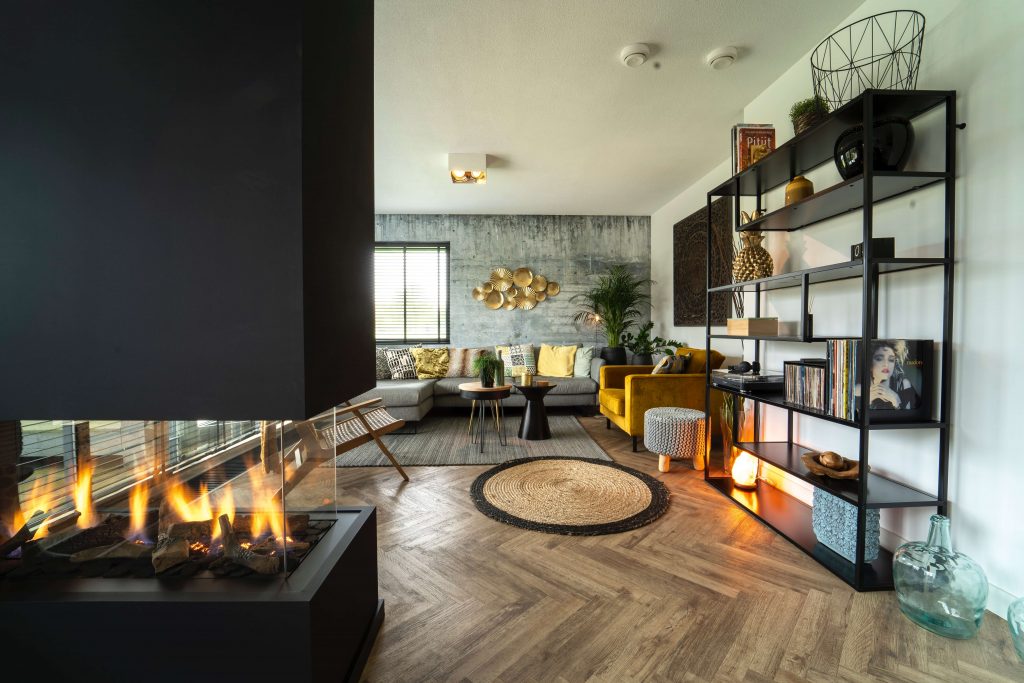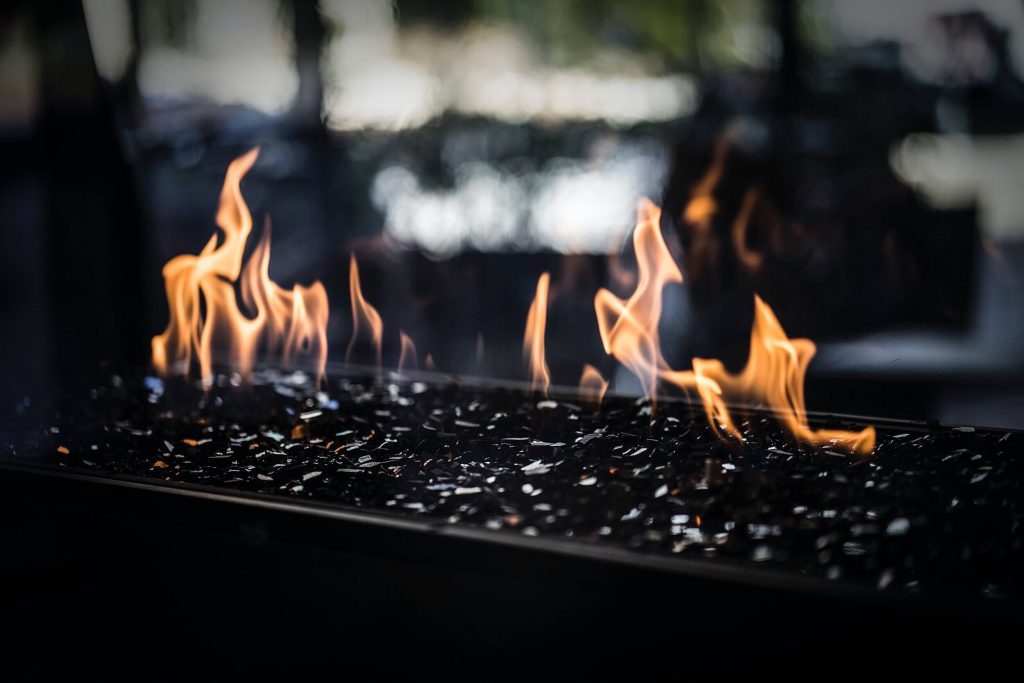The Pros and Cons of Having A Fireplace
Before making important decisions that will have important implications, it is best to count the cost. By this, we mean that as with almost every other thing, while installing a fireplace has its upsides, there may be a con or two which you ought to be aware of.
Pros and Cons of having a fireplace
Pros |
Cons |
|
|
Different Types of Fireplaces
In today’s market, there are a bunch of options open to you when choosing a fireplace. The type of fireplace you choose will largely depend on the size of your pocket and the feasibility of installing it in the kind of home you live in. For example, if you live in an apartment and without a chimney, installing a fireplace that requires a chimney is not an option to consider. The types of fireplaces are:

Wood-burning fireplaces
Wood-burning fireplaces were the original or first type of fireplaces to be utilized. As its name suggests, wood-burning fireplaces are fueled with wood. Even though wood-burning fireplaces will require tending to, one factor that sways people into choosing wood-burning fireplaces is the natural scent and crackling sound emanating from the wood.
Pros |
Cons |
|
|
Wood-burning fireplaces require annual maintenance and inspection and cost upwards of $2,500 including installation.
Source: Stamford Fireplaces

Ethanol-burning fireplaces
Ethanol-burning fireplaces or alcohol-burning fireplaces utilize ethanol as fuel and are both cost-effective and eco-friendly. Ethanol is a renewable fuel that is sourced from fermenting plants such as soybeans and corn. Besides utilizing one of the cleanest fuel sources, ethanol-burning fireplaces do not require vents.
Pros |
Cons |
|
|
Maintaining an ethanol-burning fireplace is easy. All you need is a wet cloth for the exterior and a dry cloth to clean up the spilled ethanol. Depending on the brand, an ethanol-burning fireplace costs $1000 on average.
Source: FIXR

Gas fireplaces
Gas fireplaces are fireplaces powered by propane or natural gas. Gas fireplaces are incredibly fast and uncomplicated to turn on. And to their credit, they come in different shapes and sizes and can be installed almost anywhere of your choosing. Additionally, Gas fireplaces come in different variants: vented gas fireplaces, vent-free fireplaces, and direct vent gas fireplaces.
Pros |
Cons |
|
|
To maintain gas fireplaces, you must ensure that the pilot light is off and that the unit has cooled down. Then, with a damp cloth, clean the glass, airflow, and louvers. A gas fireplace costs an average of $4000.
Source: FIXR

Electric fireplaces
In this digital world, electric fireplaces have become a trendy new piece of accessories for modern houses. Electric fireplaces are electric heaters that create a projection of flames while providing substantial heat for your home.
Pros |
Cons |
|
|
Maintenance should be carried out at least every 6 months. To maintain an electrical fireplace, first, you must disconnect it from its entire power source, conduct regular checks on its wires and plugs to ensure that they are not worn out, and clean it’s heater. Using a damp cloth to clean the interior and exterior part of the glass is also advised. And there’s no gainsaying that all this should be carried out when the electric fireplace is cool. Electric fireplaces can cost as low as $200 for a small one yet their average cost is $900.
Source: FIXR
Types of Fireplace Inserts
Fireplace Inserts are devices attached to regular fireplaces to improve the heat that they emit. There are different types of fireplace inserts, namely: wood-burning fireplace inserts, ethanol fireplace inserts, gas fireplace inserts, and electric fireplace inserts. We will now consider what these are:
Types of wood-burning fireplace inserts
Wood-burning fireplace inserts are very complex. They are fueled by wood or their byproducts and crafted to fit into a regular wood fireplace. Wood-burning fireplaces utilize the chimney of your home as vents and are thus attached to a connector. The pros of wood-burning fireplaces lie in the fact that they work without electric power. Wood-burning fireplace inserts also emit less smoke due to the former restrictions and guidelines handed to manufacturers.
One con of wood-burning fireplace inserts is their need for regular maintenance and inspection.
Types of ethanol-burning fireplace inserts
If you haven’t used your fireplace in a long while, ethanol-burning fireplace inserts are the way to go. What makes choosing ethanol-burning fireplace inserts so appealing to most is the fact that it is a simple option. All you need to do is affix the ethanol-burning fireplace Insert into the fireplace, fuel the burner, and light it up.
One pro of ethanol-burning fireplace inserts is that you do not require a chimney to own or install one in your home. Additionally, besides their general eco-friendly nature, ethanol-burning fireplace inserts are also easy to use and maintain.
Ethanol-burning fireplace inserts are good for people who are very conscious about caring for the planet by reducing harmful gas emissions.
Types of gas fireplace inserts
Gas fireplace inserts are inserts that are powered by propane or natural gas. Gas fireplace inserts are usually connected to your home’s gas line and release burnt carbon through the chimney of your home. Gas fireplace inserts produce a lot of heat and give new life to your old or abandoned fireplace.
One advantage of gas fireplace inserts is that they produce a lot of heat. Another is that they guarantee your fireplace looks traditional.
A disadvantage of gas fireplace inserts is poisoning through carbon monoxide as a result of leakage in your gas line. Gas fireplace inserts are good for individuals who already utilize gas and do not want the hassle of regular maintenance.
Types of electric fireplace inserts
Electric fireplace inserts are inserts that run on electric energy. Electric fireplace inserts are easy to use as all you need to do is plug them into a power source.
The main pro to Electric fireplace inserts lies in the fact that they are dual-purposed. Just as they can be used to heat your household, they can be used to decorate your home due to their glow. A con of Electric fireplace inserts is that since they are powered by electricity, once the power goes off, so do your Electric fireplace inserts.
Electric fireplace inserts are particularly good for those who reside in older homes where their fireplaces have been abandoned for years.
The Cost of Fireplaces and Installation
The cost of fireplaces and installation is determined by so many factors. We have outlined a few.
Factors affecting fireplace cost
The Brand: As with any other product, branding weighs in on the price of fireplaces. The more popular a brand is, the more likely it is that its products will be expensive.
The Size: Fireplaces come in different sizes. The size of a fireplace usually determines the cost. Generally, the bigger the size, the more expensive a fireplace is likely to be.
Modifications: If installing a fireplace entails merely inserting it into an already carved out mantle, the cost will likely not be as expensive as where several modifications and adjustments have to be made to accommodate the fireplace.
Average cost of a fireplace with insert and installation in Canada
|
Type of fireplace |
The average cost of a fireplace with installation and insert included |
|
Wood-burning fireplace |
Between $3,500 – 5,000 $ |
|
Ethanol-burning fireplace |
Between $700 – $6,000 |
|
Gas fireplace |
Between $2,000 – $4,000 |
|
Electric fireplace |
Between $400 – $2000 |
The average cost of a fireplace stove without installation and insert in Canada
|
Type of stove/unit |
Average cost of stove/unit |
|
Wood-burning stove |
Between $ 400 – $3,500 |
|
Ethanol-burning stove |
Between $700 – $1,400 |
|
Gas fireplace |
Between $ 100 – $3,000 |
|
Electric fireplace |
Between $ 100 – $6,200 |
Sources: HomeGuide & FIXR
FAQ – The Most Frequently Asked Questions About Fireplaces
How do you clean a gas fireplace glass?
As a general rule, abide by the rules provided in your device manual to clean your gas fireplace glass. The instruction manual may provide that you turn off the fireplace and let it cool off. Then, open or remove the glass and place it on a soft surface so that it doesn’t break. Next, use a special cleanser by spreading it across the glass with a soft damp cloth and allow it to sit on the glass for a while. Finally, wipe off the cleaner. Repeat this same action to clean the front of the glass.
How do you turn on a gas fireplace?
As a general rule, abide by the instructions provided in the user manual since fireplaces differ. Alternatively, open the outer cover of the fireplace; insert the key into the gas valve of the fireplace, ignite a lighter close to the burner and then turn the gas key and done!
Do you need to clean a gas fireplace chimney?
Yes, you need to clean a gas fireplace chimney. While it is true that a gas fireplace does not produce as much soot as other fireplaces, it is still pertinent that you clean it annually not just to remove creosote, but to dispose of things like debris and bird nests.
Does a wood-burning stove reduce humidity in a home?
Yes, studies have shown that wood-burning stoves reduce humidity in a home. To prevent dry sinuses and your lips from cracking as a result of low humidity caused by a wood-burning stove, turn on a humidifier or place water on the wood-burning stove.
How often should you get your chimney cleaned?
It is advisable to get the chimney cleaned at least once a year to prevent debris from causing a health and fire hazard.
Do electric fireplaces provide heat?
Yes, some electric fireplaces provide enough heat to heat up and warm a room through an electric or infrared heater.
Where is the use of a wood-burning fireplace banned in Canada?
Wood-burning fireplaces are banned in the Greater Montreal area. Other provinces of Canada merely have restrictions placed on fireplaces and stoves that do not meet the standards. However, wood-burning is generally banned during smog and when the weather is very dry.
Conclusion
Fireplaces are an intricate part of Canadian life. Fireplaces provide warmth and comfort and are definitely worth the hefty upfront costs. If you don’t have the budget for the typical fireplace, you can always opt for a small electric fireplace.






